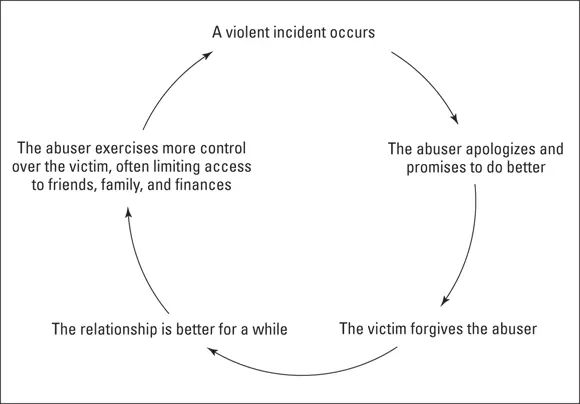For example, if you pull out a gun and tell someone you’re going to shoot him, you’re committing an assault (among other offenses). If you actually shoot the person without killing him, you’re committing a battery.
 The seriousness of these types of crimes and the sentences they warrant in court generally depend on whether a weapon is used and on how severe the harm caused is. Here are two key distinctions:
The seriousness of these types of crimes and the sentences they warrant in court generally depend on whether a weapon is used and on how severe the harm caused is. Here are two key distinctions:
Simple assault or battery refers to conduct that results in low-level physical injury, not serious injury. It’s typically punished as a misdemeanor with only a little jail time.
Aggravated assault or battery refers to serious felony conduct that involves the use of a dangerous or deadly weapon or that results in serious injury. Aggravated assault or battery may result in a lengthy prison sentence of one to ten years (or even more, depending on the circumstances).
The types of conduct that can result in a criminal charge of battery (or assault) are almost limitless, but here are a few examples:
Punching or slapping
Stabbing
Shooting
Using any object as a weapon to cause an injury
Crashing a vehicle
I once prosecuted someone who repeatedly kicked another person using steel-toed boots. I charged the defendant with battery with a “dangerous weapon,” a charge that resulted in a longer sentence than the defendant would’ve received for wearing slippers (for which he would only get a simple battery charge).
In the following sections, I discuss the major crimes involving assault and battery.
Car crashes are the most common means of violent death or serious physical injury in the United States. One person dies every 50 minutes. Groups such as Mothers Against Drunk Driving (MADD) have helped elevate society’s awareness of the damage that can be done by a speeding, three-ton pile of metal. As a consequence, many states have created offenses, such as vehicular assault, that criminalize dangerous driving that results in injury. However, just crashing a car and injuring someone isn’t enough to constitute a crime. In most states, the driver must have driven recklessly to warrant a charge.
Although reckless driving can involve a number of behaviors, such as speeding or running a red light, intoxication is by far the primary factor prosecutors use in proving vehicular assault, in part because intoxication with alcohol or drugs is involved in so many crashes. If a driver wasn’t intoxicated during a crash, to win a conviction of vehicular assault, a prosecutor has to prove very bad driving judgment (such as drag racing on a busy street).
Sentences for vehicular assault often depend on the severity of the victim’s injury. A sentence can range from probation with no jail to eight or more years in prison.
Also known as domestic assault or intimate partner violence, spousal assault usually involves violence between domestic partners and is most often committed by men toward women. Female victims of such violence are usually emotionally attached and often financially dependent on their abusers, which may lead them to go through what’s known as the cycle of domestic violence (see Figure 5-1).
Domestic violence victim services are much more commonplace today than 20 years ago. These services include short-term shelters for women and children fleeing from violence, along with counseling and employment services to help victims break the cycle. Perhaps not coincidentally, victimization survey results show that incidents of domestic violence in the United States have been steadily declining since 1993. (Check out Chapter 3for more on victimization surveys and Chapter 4for more on victim services.)

FIGURE 5-1:The cycle of domestic violence.
 Keep in mind, though, that gathering a true statistical picture of the scope of intimate partner violence is difficult. By nature, this violence occurs within the home — away from witnesses — which makes arrest and prosecution difficult.
Keep in mind, though, that gathering a true statistical picture of the scope of intimate partner violence is difficult. By nature, this violence occurs within the home — away from witnesses — which makes arrest and prosecution difficult.
In cases of spousal assault, conflicts sometimes occur between law enforcement officers and victim service providers. Law enforcement officers are generally concerned with obtaining evidence to punish the violent offender. On the other hand, victim service providers want to protect the victim. In doing so, they may take actions that inhibit an investigation, such as refusing to disclose the victim’s location to police.
Fortunately, as victims’ rights have become a more significant part of the criminal justice system, such conflicts are becoming less common (see Chapter 4for more on victims’ rights). Nonetheless, finding a female domestic violence victim who is willing to cooperate with the prosecution against an offender is still unusual. Often, the victim refuses to cooperate.
Because most domestic violence doesn’t involve severe injuries, a typical sentence for a spousal assault charge involves probation and some jail time, along with requirements to complete anger management training and perhaps drug or alcohol treatment. Sometimes, however, spousal abuse does result in serious injury to the victim. When that occurs, the offenders may receive prison sentences of one to ten years or more.
 Child abuse is a great concern to policymakers and the public. Today the term child abuse means more than just physical violence against children; it also includes neglect and mistreatment.
Child abuse is a great concern to policymakers and the public. Today the term child abuse means more than just physical violence against children; it also includes neglect and mistreatment.
Traditionally, courts have shown great deference to parents with regard to child-rearing strategies, but criminal child abuse or child neglect is generally far beyond anything that can be considered “parenting.” For example, in the homes of parents who are drug addicts, it’s common to find pet and human feces throughout the house, garbage piled up so that the floor isn’t even visible, and drug paraphernalia strewn about. Children may regularly watch their parents do drugs, and they may go without proper food or medical care for extended periods of time.
In addition to narcotics abuse, which is an issue in many child abuse cases, parents may also abuse children because they learned the behavior from their own parents. If parents were abused as children, they may not know other skills for dealing with children and may resort to violence when they’re angry or frustrated. Such violence can include physically beating a child, hitting a child with a belt or bat, burning a child’s skin with a cigarette, and shaking a baby. (Because an infant’s brain is so vulnerable, just one or two violent shakes can result in serious injury or even death — a situation called shaken baby syndrome. )
Like violent crime in general, incidents of child abuse have been dropping over the last 25 years. Still, an estimated 1,600 children died as a result of abuse or neglect in 2016. And over 74 percent of child abuse takes the form of neglect — failing to provide basic, essential services rather than physical or sexual violence.
Sentences for child abuse can range from probation to lengthy prison sentences. Judges prefer to keep families intact — if doing so won’t put the child in danger — so probationary sentences that require the defendant to undergo parenting education and drug or alcohol treatment are fairly common.
Читать дальше

 The seriousness of these types of crimes and the sentences they warrant in court generally depend on whether a weapon is used and on how severe the harm caused is. Here are two key distinctions:
The seriousness of these types of crimes and the sentences they warrant in court generally depend on whether a weapon is used and on how severe the harm caused is. Here are two key distinctions:
 Keep in mind, though, that gathering a true statistical picture of the scope of intimate partner violence is difficult. By nature, this violence occurs within the home — away from witnesses — which makes arrest and prosecution difficult.
Keep in mind, though, that gathering a true statistical picture of the scope of intimate partner violence is difficult. By nature, this violence occurs within the home — away from witnesses — which makes arrest and prosecution difficult.










